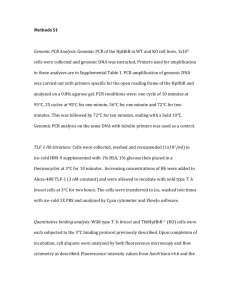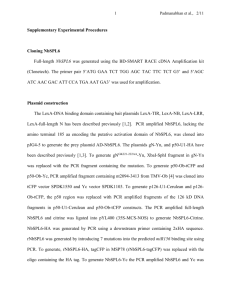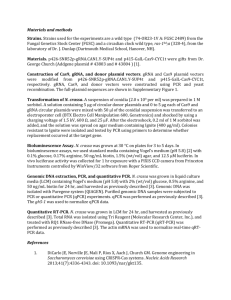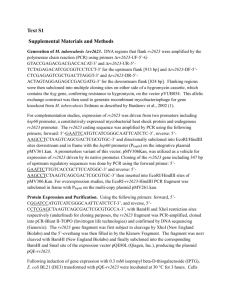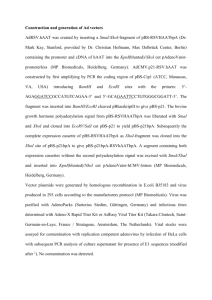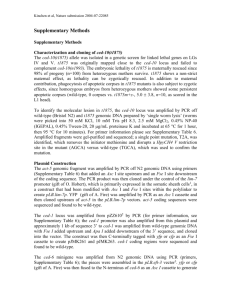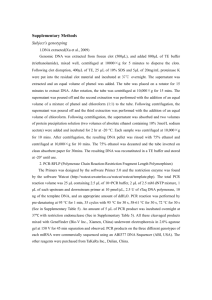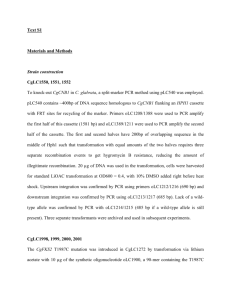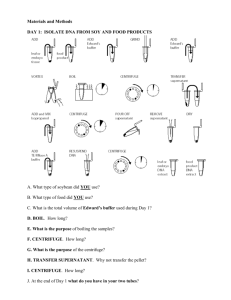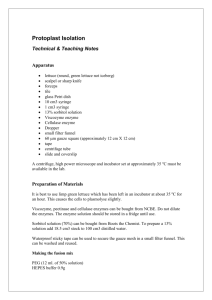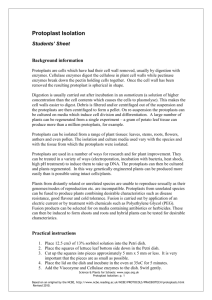TPJ_4883_sm_TexS1
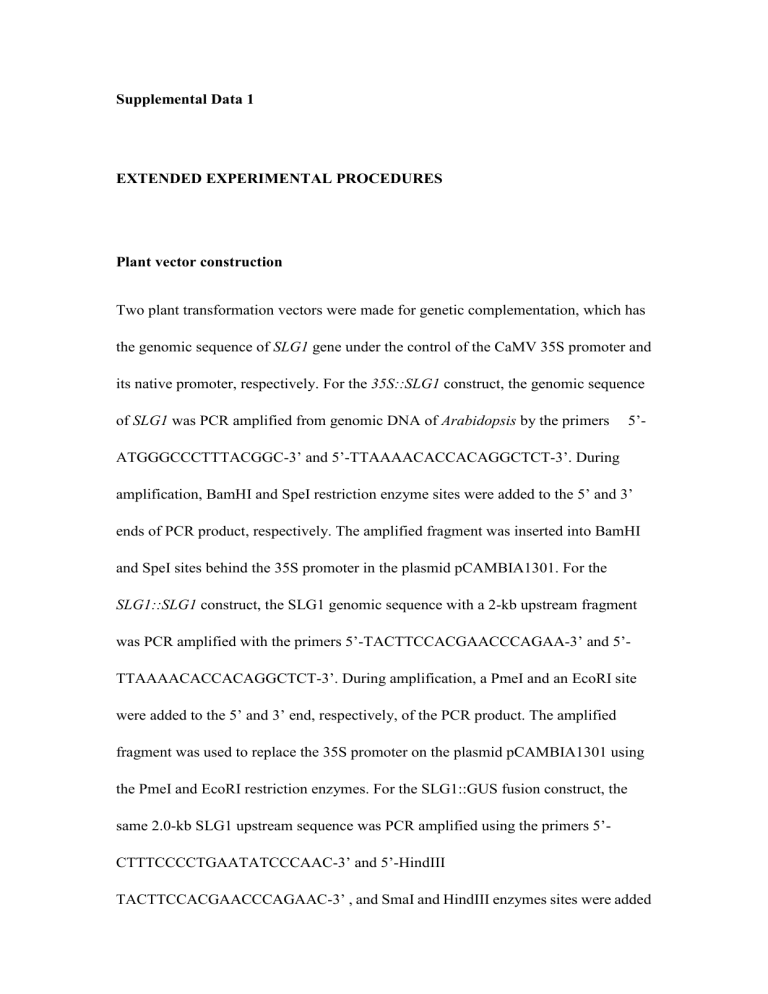
Supplemental Data 1
EXTENDED EXPERIMENTAL PROCEDURES
Plant vector construction
Two plant transformation vectors were made for genetic complementation, which has the genomic sequence of SLG1 gene under the control of the CaMV 35S promoter and its native promoter, respectively. For the 35S::SLG1 construct, the genomic sequence of SLG1 was PCR amplified from genomic DNA of Arabidopsis by the primers 5’-
ATGGGCCCTTTACGGC-3’ and 5’-TTAAAACACCACAGGCTCT-3’. During amplification, BamHI and SpeI restriction enzyme sites were added to the 5’ and 3’ ends of PCR product, respectively. The amplified fragment was inserted into BamHI and SpeI sites behind the 35S promoter in the plasmid pCAMBIA1301. For the
SLG1::SLG1 construct, the SLG1 genomic sequence with a 2-kb upstream fragment was PCR amplified with the primers 5’-TACTTCCACGAACCCAGAA-3’ and 5’-
TTAAAACACCACAGGCTCT-3’. During amplification, a PmeI and an EcoRI site were added to the 5’ and 3’ end, respectively, of the PCR product. The amplified fragment was used to replace the 35S promoter on the plasmid pCAMBIA1301 using the PmeI and EcoRI restriction enzymes. For the SLG1::GUS fusion construct, the same 2.0-kb SLG1 upstream sequence was PCR amplified using the primers 5’-
CTTTCCCCTGAATATCCCAAC-3’ and 5’-HindIII
TACTTCCACGAACCCAGAAC-3’ , and SmaI and HindIII enzymes sites were added
to the 5’ and 3’ ends, respectively, of the PCR product. This fragment was then cloned into SmaI and HindIII sites before the GUS gene in the plasmid pBI121. For
35S::SLG1-GFP fusion construct, the SLG1 genomic sequence was amplified by the primers 5’-ATGGGCCCTTTACGGCAATT-3’ and 5’-BamHI
TTAAAACACCACAGGCTCTTTC-3’ and then inserted behind the GFP gene in the plasmid pEGAD using the restriction enzymes SmaI and BamHI.
Protoplast isolation and transformation
Protoplasts were isolated and transformed using methods developed in the Dr. Niyogi’s laboratory (http://nature.berkeley.edu/niyogilab/index.html) with slight modification.
Briefly, leaves were cut from 4-week-old seedlings into strips and incubated in 1 M mannitol for 30 min at room temperature. The mannitol solution was then discarded, and an enzyme solution (pH 5.6) containing 1% cellulose R-10 (W/V, Yakult,
9012-54-8), 0.25% macerozme R-10 (W/V, Yakult, 9032-75-1), 0.2% MES(W/V),
0.1% BSA(W/V), 500 mM mannitol, and 1 mM CaCl
2
was added, and the preparation was gently shaken in the dark for 12 h. After the protoplasts were filtered through a
100-mesh sieve, 30 ml of W5 solution (154 mM NaCl, 125 mM CaCl
2
, 5 mM KCl, 5 mM glucose, and 1.5 mM MES, with pH adjusted to 5.6 by 1 M KOH) was added to 20 ml of the filtered protoplast suspension, and the suspension was centrifuged for 10 min at 400 rpm at room temperature using a swinging bucket rotor. The pelleted protoplasts were resuspended in W5 solution. After the suspension was incubation on ice for 2 h,
the W5 solution was discarded and an appropriate volume of MaMg solution (400 mannitol, 15 mM MgCl
2
, and 0.1% MES [W/V], pH 5.6 adjusted with 1 M KOH) added to obtain a suspension containing 5×10
6
cells/ml. A 300-ul volume of solution was combined with 300 μl of PEG solution (40% PEG4000 [W/V], 400 mM mannitol, 100 mM Ca(NO
3
)
2
) containing 10–30 μg of plasmid DNAs isolated with
High Pure Plasmid Kit (TIANGEN, DP116); this preparation was mixed and by gentle inversion for 30 min at room temperature. The protoplast suspension was gently diluted with W5 solution to 5 ml and centrifuged at 350 rpm for 5 min. The protoplasts were resuspended in 2 ml of W5 solution and incubated at room temperature overnight. The fluorescent signals were observed with a Zeiss LSM 710 microscope.
Detection of enzyme activity of complex I
The NADP dehydrogenase activity of mitochondria complex I was analyzed to Pineau et al.
(2008). A 200-mg quantity of 8-day-old seedlings was ground on ice with 2 ml of extraction buffer (0.6 M sucrose, 0.2% BSA[W/V], 4 mM EDTA, 0.4%
PVP40[W/V], 8 mM cystenin, 75 mM Mops-KOH at pH 7.6, and 1 mM PMSF). The ground samples were centrifuged at 1300 g for 5 min at 4
℃
. The supernatant was collected and centrifuged again at 22,000 g for 10 min. The sediment was in 200 ul of wash buffer (0.3 M sucrose, 10 mM Mops-KOH at pH 7.2) and 600 ul of
H
2
O, and centrifuged at 22, 000 g for another 10 min. The pellet containing the membrane fractions was dissolved in 1×sample buffer (Invitrogen, BN2003).
β-dodecyl maltoside (DDM) was then added to a final concentration of 1%. After
incubation on ice for 30 min, the samples were centrifuged at 22,000 g for 20 min, and the supernatants were collected. The supernatants containing 20 ug of proteins were electrophoresed on Blue-Native PAGE (Invitrogen, BN1002BOX). To detect the enzyme activity of mitochondria complex I, the gel was immersed in staining buffer
(0.2 mM NADH, 1 mM NBT, and 50 mM Mops-KOH at pH 7.6 ) for 20 min at room temperature. The reaction was then stopped by immersing the gel in fixing solution with 30% methanol (V/V) and 10% acetic acid (V/V) (de Longevialle et al.
, 2007). de Longevialle AF, Meyer EH, Andres C, Taylor NL, Lurin C, Millar AH, Small
ID. 2007.
The pentatricopeptide repeat gene OTP43 is required for trans-splicing of the mitochondrial nad1 Intron 1 in Arabidopsis thaliana.
Plant Cell 19 (10): 3256-3265.
Pineau B, Layoune O, Danon A, De Paepe R. 2008.
L-galactono-1,4-lactone dehydrogenase is required for the accumulation of plant respiratory complex I.
J Biol Chem 283 (47): 32500-32505.
